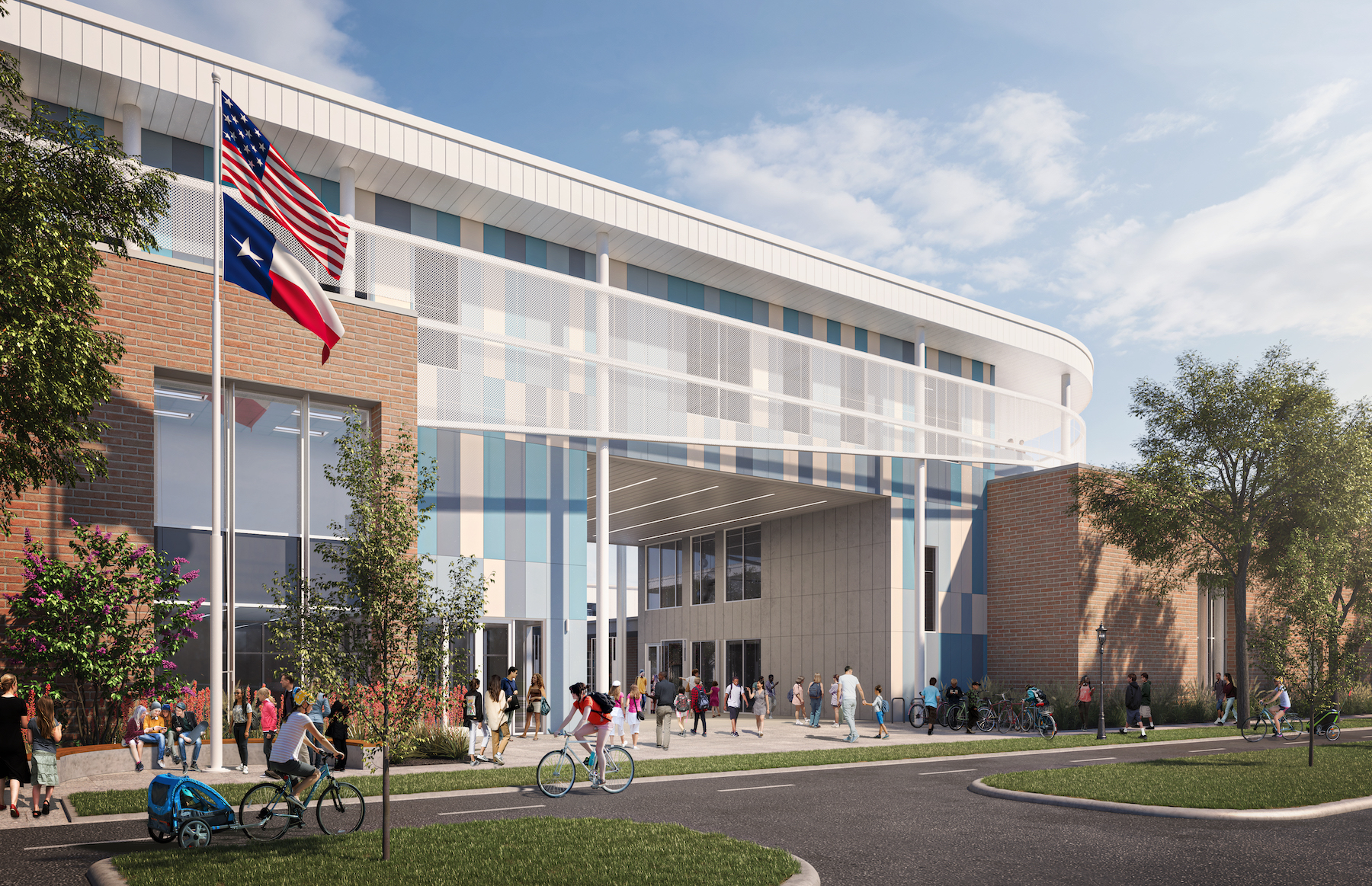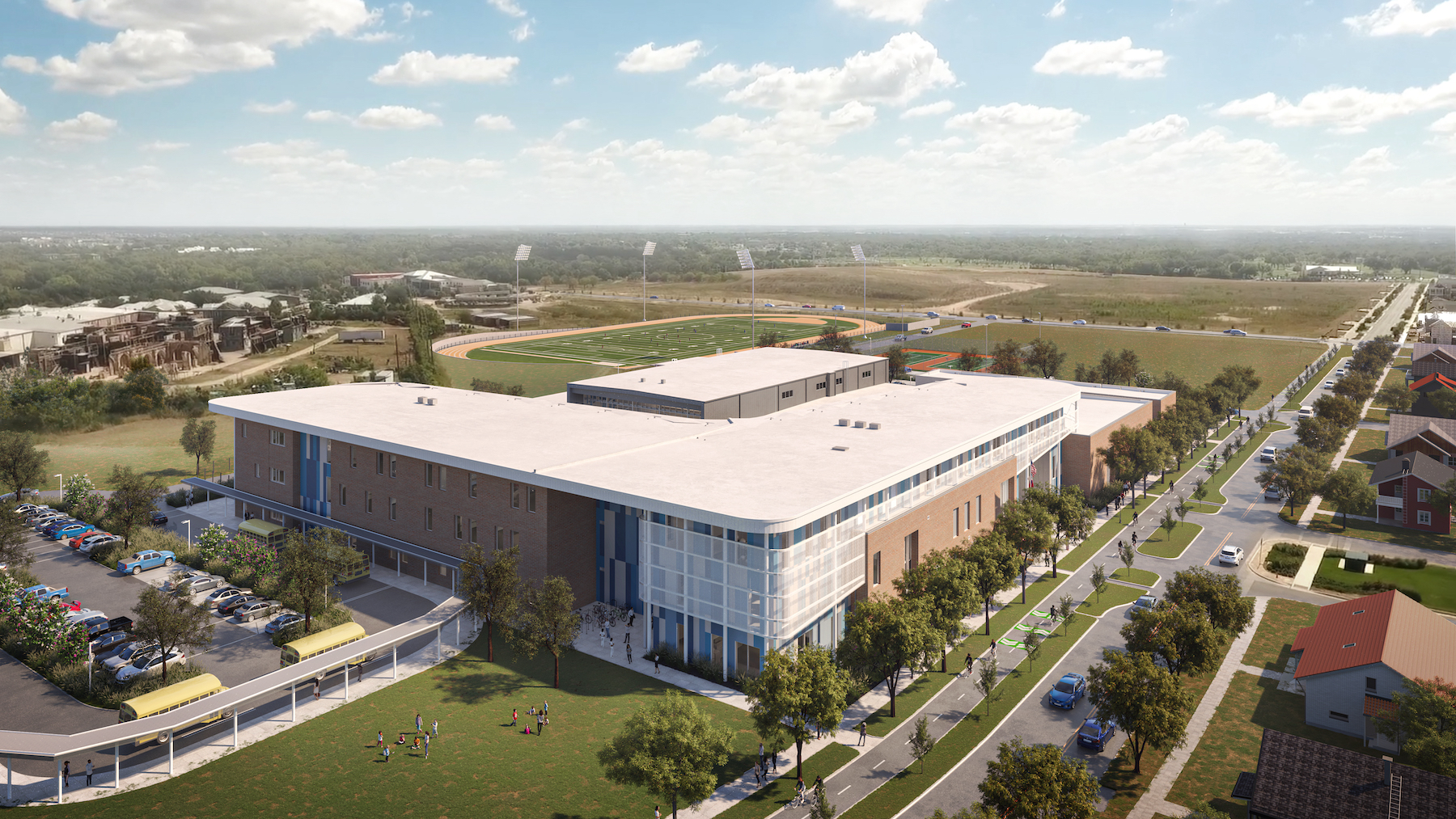Mueller is a 700-acre master-planned community located three miles from Austin, Texas, on what had been the Robert Mueller Municipal Airport that dated back to the late 1920s.
A public-private partnership between the City of Austin’s Economic Development Department and Catellus Development Corporation, Mueller, upon its build out within the next decade, will encompass at least 6,900 homes and apartments, a 42-acre mixed-use town center known as Aldrich Street, 5.5 million sf of commercial space, 750,000 sf of retail space, a medical center, film studio, children’s museum, an 83,000-sf grocery store, and 140 acres of parks and open spaces.
In support of this “new urbanist” environment, the Austin Independent School District—which already owns a performing arts center that opened within Mueller in early 2015—last August started construction on a 130,000-sf Middle School on 10 acres along the northeast section of the city and Mueller, that will double as a hub that links the school to this community’s neighborhoods. The middle school, with an 800-student capacity for 6th through 8th graders, is expected to be ready to accept students and teachers in August 2023.
The new middle school “will contribute to the fabric of the community,” predicts Kate Mraw, ALEP, RID, LEED AP BD+C, principal and design director for LPA, the architect on this project. The school will connect to Mueller’s bike and hiking trails, and offer a park and other public spaces on its premises. And because it will draw students from beyond the immediate neighborhood, it will bring greater diversity into the community.
A QUICKER WAY TO BUILD SCHOOLS
LPA and Coleman Landscape Architects are working with Joeris General Contractors, which the Austin ISD hired to spearhead this design-build project.
Burton Hackney, Vice President of Central Texas for Joeris General Contractors, tells BD+C that while the design-build delivery method is still the exception for building schools in the Lone Star State, “after the bond passed, [the district] needed a way to get some schools up quickly.” The Mueller project is one of 19 new constructions and modernizations that the Austin ISD is engaged in, funded by a $1 billion bond that voters passed in late 2017.
Hackney, an Austin native, says the airport redevelopment has long been thought of locally as “sacred space.” At one time, a new elementary school was on the table. But, he recalls, the district’s circumstances changed: at the time the bond was floated, more than 1,000 middle school students had been leaving the region from nearby charter schools, according to the ISD’s Facility Master Plan.
This is Joeris’ second design-build project for the district. Hackney says his firm’s culture “aligns” with that delivery method because it emphasizes lean principles. “We didn’t have to go through the value-engineering process because the GC was involved in all the meetings right from the start,” confirms Mraw.
DEMOCRATIC DESIGN

The Building Team is pretty much working from the ISD’s design documents. But the design process also included “a diverse stakeholder group that was heard from,” says Hackney. Catellus had a representative on the architecture team. And Mueller “was very specific about what it wanted,” he states.
During the design phase for the middle school, there were 16 architectural team meetings, four community meetings, and seven neighborhood meetings. The Austin ISD initiated those early talks, which Mraw says focused on “hopes, goals, and dreams,” as well as the importance of sustainability.
Mueller was the first neighborhood in Texas to earn LEED for Neighborhood Development Stage 3 Gold Certification. All the roofs of the Austin ISD Middle School will be solar ready. Durable and environmentally friendly materials are being used throughout, and 100 percent recycled water will irrigate the site’s vegetation. The school’s design—which takes into account its orientation to the sun—is expected to reduce energy use by 32 percent from a baseline standard.
The school design also pays homage to the original Mueller airport with a large, wing-shaped roof, a gymnasium that resembles an aircraft hangar, and runway-inspired wayfinding graphics throughout the campus.
A NOD TO THE PAST

Hackney says there was budgetary discussion, during the design phase, about what kinds of materials to use for the school’s exterior skin to resemble the Art Deco-like pattern of the eight-story airport tower, which is still standing. (The tower’s dark and light blue panels were restored several years ago.) The agreed-upon material is an integral-colored fiber cement panel made by the manufacturer TAKTL.
According to LPA, other exterior building materials are being used, too, including brick masonry veneer, a perforated and corrugated white metal screen, and anodized aluminum for the metal soffit and roof fascia panels.
The school’s roof and stacking also went through some changes to address budgetary concerns. The project’s total cost is $53.2 million, of which $45.5 million is for construction.
Related Stories
| Oct 9, 2014
Regulations, demand will accelerate revenue from zero energy buildings, according to study
A new study by Navigant Research projects that public- and private-sector efforts to lower the carbon footprint of new and renovated commercial and residential structures will boost the annual revenue generated by commercial and residential zero energy buildings over the next 20 years by 122.5%, to $1.4 trillion.
| Sep 29, 2014
Living Building vs. LEED Platinum: Comparing the first costs and savings
Skanska USA's Steve Clem breaks down the costs and benefits of various ultra-green building standards and practices.
| Sep 24, 2014
Architecture billings see continued strength, led by institutional sector
On the heels of recording its strongest pace of growth since 2007, there continues to be an increasing level of demand for design services signaled in the latest Architecture Billings Index.
| Sep 22, 2014
4 keys to effective post-occupancy evaluations
Perkins+Will's Janice Barnes covers the four steps that designers should take to create POEs that provide design direction and measure design effectiveness.
| Sep 22, 2014
Sound selections: 12 great choices for ceilings and acoustical walls
From metal mesh panels to concealed-suspension ceilings, here's our roundup of the latest acoustical ceiling and wall products.
| Sep 9, 2014
Using Facebook to transform workplace design
As part of our ongoing studies of how building design influences human behavior in today’s social media-driven world, HOK’s workplace strategists had an idea: Leverage the power of social media to collect data about how people feel about their workplaces and the type of spaces they need to succeed.
| Sep 7, 2014
Behind the scenes of integrated project delivery — successful tools and applications
The underlying variables and tools used to manage collaboration between teams is ultimately the driving for success with IPD, writes CBRE Healthcare's Megan Donham.
| Sep 4, 2014
Best of education design: 11 projects win AIA CAE architecture awards [slideshow]
The CAE Design Excellence Award honors educational facilities that the jury believes should serve as an example of a superb place in which to learn. Projects range from a design school in Maryland to an elementary school in Washington.
Sponsored | | Sep 4, 2014
Learning by design: Steel curtain wall system blends two school campuses
In this the new facility, middle school and high school classroom wings flank either side of the auditorium and media center. A sleek, glass-and-steel curtain wall joins them together, creating an efficient, shared space. SPONSORED CONTENT
| Sep 3, 2014
New designation launched to streamline LEED review process
The LEED Proven Provider designation is designed to minimize the need for additional work during the project review process.
















